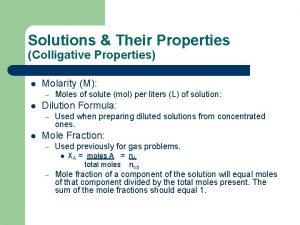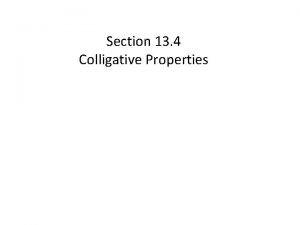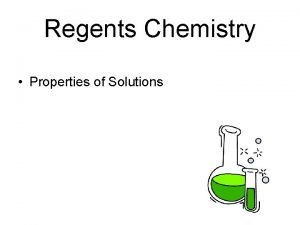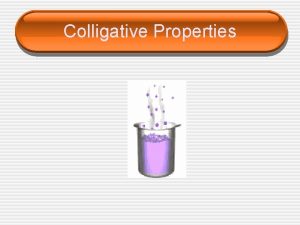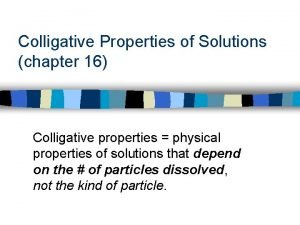COLLIGATIVE PROPERTIES OF SOLUTIONS Colligative Properties A property









- Slides: 9

COLLIGATIVE PROPERTIES OF SOLUTIONS

Colligative Properties A property that depends only upon the number of solute particles, and not upon their identity � Vapor-Pressure Lowering � Boiling Point Elevation � Freezing Point Depression

Vapor Pressure A solution with nonvolatile solute has a lower vapor pressure than the pure solvent Decrease in a solution’s vapor pressure is proportional to the # of solute particles in solutions Example 0. 10 M solute in 1000 g H 20 � glucose (1 particle) � Na. Cl Na+Cl (2 particles) 2 x the effect � Ca. Cl 2 Ca+Cl+Cl (3 particles) 3 x the effect

FP depression and BP elevation Freezing Point Depression ( tf) � f. p. of a solution is lower than f. p. of the pure solvent � magnitude of the fp depression is proportional to the number of solute particles � Solute particles disrupts the formation of the solid Boiling Point Elevation ( tb) � b. p. of a solution is higher than b. p. of the pure solvent � magnitude of the bp elevation is proportional to the number of solute particles

Freezing Point Depression

Boiling Point Elevation Solute particles weaken IMF of solvent

Applications salting icy roads making ice cream antifreeze � cars (-64°C to 136°C)

Mole Fraction Ratio of the moles of that solute to the total number of moles of solvent and solute Moles of ethylene glycol (n. EG) is 1. 25 mol EG Moles of water (n. H 20) = 4. 00 mol H 20

FP and BP Calculations ΔTf = Kfmn ΔTb=Kbmn �K = constant dependent on the solvent (ºC/m) � m = molality � n = number of particles What is the boiling point of a 1. 50 m Na. Cl soln? �m = 1. 50 m n=2 (Na+Cl) K= 0. 512ºC/m � ΔTb= (0. 512ºC/m)(1. 50 m)(2)=1. 54 � Tb = 101. 54ºC


